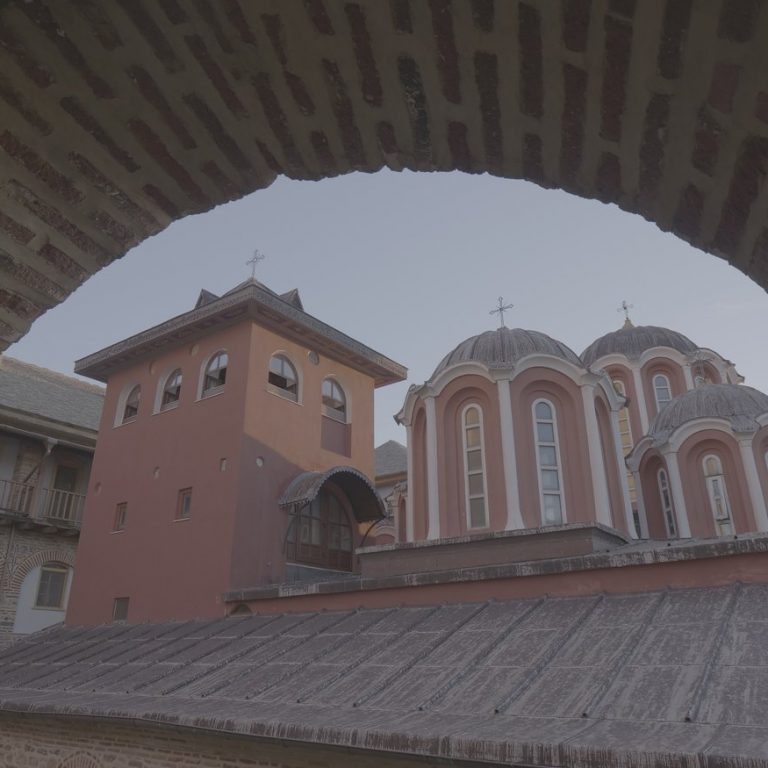Period 1 (To 1568)
Agios Oros fell under Ottoman control in 1423/4. During the period which followed, the Monastery, under the leadership of the hieromonk Nicandro (1423), managed to advance the interests of the Monastery despite the adverse conditions: He accepted a significant number of donations and new dependencies or metochies (i.e. a property belonging to the Monastery but located outside of it). These acquisitions reinforced the Monastery economically, thereby placing it in a relatively strong financial position. In 1471, under the tenure of the Abbott Ignatios, the Monastery was visited by the Patriarch of Konstantinople Dionysius I, who was the student of St Mark of Ephesus, at which time a number of issues relating to the Monastery were settled. (After his first resignation from the ecumenical throne, Dionysius became the founder of the Eikosifinissa Monastery in Paggaio.
During that same period, Abbott Ignatios Zagrifas, the former head of the Monastery, was appointed as head of the Agios Oros community, a position which he held from 1483-1496. Several decades later, in 1522, the same honour was bestowed on another member of the Pantokratoros Monastery, the hieromonk Nifon.
The end of the 15th century through the entire 16th century was a period of spiritual renascence of the subjugated Hellenic tradition. The Monastery was strengthened, as were other Athonite monasteries, by Orthodox rulers in the region around the Danube. The first benefactor was the Blachian leader Staikos, who is characterized in a 1501 document as the new patron of the Monastery, and his son-in-law, Neagoe of Peris (1516-1529). Another Blachian patron who provided significant assistance to the Monastery at this time was Neagoe Vasarab Craiovescu (1512-1521), a person known for his special relationship with the hieromonk Nifon. Craiovescu is characterized in Romanian biographies as being the patron of both the Pantocratoras and Iviron monasteries.
Renovations being carried out at the Monastery during this period are linked with the names of two additional Moldavian-Blachian officers: (a) Barboulo, whom Barsky characterizes as the third patron of the Monastery. However, based on surviving evidence, it is not possible to identify him with one of the anonymous officers who are remembered during that period, and (b) the great Moldavian leader (1516-1523, 1539-1541) Gabriel Totrusanu, who financed the repair of the Byzantine aqueduct system at the Monastery in 1536/7. Other patrons around this time (1560-1568) were Count Barcan and his three sons, Radul, Manea and Diicul, who financed the construction of the silver embellishments to the Bible of St John of Kalyvito.
Along with the endowments to the Monastery used for major repairs to the physical structures and facilities, in September 1537, the patriarch Jeremiah I reaffirmed the independence of the Monastery and its rights in a sigilli, as they had been defined in an earlier edict of the Patriarch Antonio IV.
The resurgence of the Monastery during this period is also confirmed by the fact that during the first half of the 16th century, a large population of monks (ranging from 40 to 215) resided there. In 1574, in a report on Agios Oros written by the patriarch Jeremiah II (Tranos), the Monastery is mentioned as having achieved the seventh place in the hierarchy of Athonite monasteries, the position which it still retains today.
During that same period, Abbott Ignatios Zagrifas, the former head of the Monastery, was appointed as head of the Agios Oros community, a position which he held from 1483-1496. Several decades later, in 1522, the same honour was bestowed on another member of the Pantokratoros Monastery, the hieromonk Nifon.
The end of the 15th century through the entire 16th century was a period of spiritual renascence of the subjugated Hellenic tradition. The Monastery was strengthened, as were other Athonite monasteries, by Orthodox rulers in the region around the Danube. The first benefactor was the Blachian leader Staikos, who is characterized in a 1501 document as the new patron of the Monastery, and his son-in-law, Neagoe of Peris (1516-1529). Another Blachian patron who provided significant assistance to the Monastery at this time was Neagoe Vasarab Craiovescu (1512-1521), a person known for his special relationship with the hieromonk Nifon. Craiovescu is characterized in Romanian biographies as being the patron of both the Pantocratoras and Iviron monasteries.
Renovations being carried out at the Monastery during this period are linked with the names of two additional Moldavian-Blachian officers: (a) Barboulo, whom Barsky characterizes as the third patron of the Monastery. However, based on surviving evidence, it is not possible to identify him with one of the anonymous officers who are remembered during that period, and (b) the great Moldavian leader (1516-1523, 1539-1541) Gabriel Totrusanu, who financed the repair of the Byzantine aqueduct system at the Monastery in 1536/7. Other patrons around this time (1560-1568) were Count Barcan and his three sons, Radul, Manea and Diicul, who financed the construction of the silver embellishments to the Bible of St John of Kalyvito.
Along with the endowments to the Monastery used for major repairs to the physical structures and facilities, in September 1537, the patriarch Jeremiah I reaffirmed the independence of the Monastery and its rights in a sigilli, as they had been defined in an earlier edict of the Patriarch Antonio IV.
The resurgence of the Monastery during this period is also confirmed by the fact that during the first half of the 16th century, a large population of monks (ranging from 40 to 215) resided there. In 1574, in a report on Agios Oros written by the patriarch Jeremiah II (Tranos), the Monastery is mentioned as having achieved the seventh place in the hierarchy of Athonite monasteries, the position which it still retains today.

